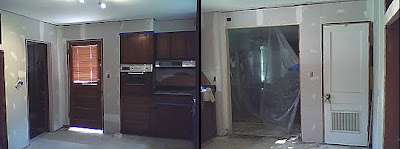I know a lot of homeowners who have a room full of 1/4″ paneling sheets and dream of flat drywall instead.
The kitchen that I’m currently remodeling in Inglewood had paneling covering the old plaster walls. Removing the paneling might have brought the plaster with it and presented a bigger project than my client wanted me to tackle. He told me to just drywall over it.
I said, “Sure. No problem.”
The wall where I widened the doorway got gutted, so it was just the other walls that we were talking about. I chose to use 3/8″ drywall for these walls. I avoided 1/4″ drywall because it doesn’t tend to dimple correctly wherever I screw. I guess it’s so thin that instead of recessing, the screws often make a small bump which is a pain to get smoothed out.
I always remove all the casing and trim to do drywall. I’ve seen homes where somebody tries to drywall up to the trim and it looks horrible even if you caulk it. It’s also likely that the edges of the drywall aren’t screwed to any studs with this method.

Like any drywall installation I had to make sure I had framing everywhere that was needed so that all of my drywall edges were snug. If a screw doesn’t hit anything solid, the drywall will eventually move enough to cause a crack at this location.
One other concern with drywalling over paneling is that your doorjambs will need to be built up to be flush with the new drywall. In my case, I’ll need to rip strips that are 3/8″ thick to attach before I can put the casing back on. The baseboard shouldn’t have this problem.
Can you mud the paneling to cover the lines?
I’ve read some discussion on this topic and I’d agree with those that say it’s not a good idea. Paneling is quite flimsy at 1/4″. Even installed over plaster there were lots of gaps and spongy places. This means that any mud that you try to fill those pesky paneling lines with will just crack and make the lines reappear.
This kitchen already looks better with the paneling hidden by new drywall with the first coat of mud.
-Peter









